Amazing photo of the unique lagoon-within-lagoon system fo the Koronissia islets in the center of the Amvrakikos Gulf (photo from: https://www.driverstories.gr/en)
Amvrakikos Wetlands, Northwest Greece
I am privileged and honoured to be a small part of the history of conservation in the Amvrakikos Gulf (one of the largest wetlands and top wildlife sites in Greece). Through this short blast to the past, I just want to recall some momments...from some rather randomly found-and-scanned shots I found.
My first birding visits were in 1984 (I have cousins in Preveza...), then in early 1985 with the Hellenic Ornithological Society begun a wonderful time for many young Greek naturalists - the Dalmatian Pelican wardening programme (I'll try to discuss that time in another post...and to find those old photos...). I was a very young birder -but totally obsessed and so were so many others in the hay-day of the Environmental Movement of the mid '80s (analogous to the West's early '70s, definately a pivotal cultural movment period in Greece...).
After such semi-voluteering projects and many visits, even guiding the first Canadian ecotourists there, and assisting in the branding for ecotourism at Amvrakikos (and doing various studies), we landed an amazing extra-ambitious LIFE -Nature Project (1999-2003). We did a lot at that time; among other things trying to create the boundaries for the "protected area" and a new National Park.
Most of the photos below are from this period (1999-2003).
The National Park was enacted on March 21st 2008 - it is far from a perfect delination and who knows what zonation will finally take place now that the new Special Environmental Studies are being completed for the area (unfortunately I am no longer personally involved in the area...). There are critical issues associated with land-use changes, hunting and disturbance around the periphery of the park (the so-called "shadow-effect" that the high-profile core of the area casts on important hotspots in the sourroundings).
Our most recent paper, refers to the conservation area "shadow-effect" through some data on the status of lesser spotted eagles; see it here:
Also a summary overview of on of the LIFE Nature restoration works at Amvrakikos, recently show-cased here:
Just a quick flashback - cheers!
 |
| The Salaora research station, was a refurbished former Ottoman costum's house. Through EU monies it was re-created in the late 1990s and this time into the Salaora Research Station. We have spent many nights here in luxury. And from this building we spotted the wonderful Aetomylaeus bovinus rays feeding in the shallows below (one of my first marine papers published)... This aerial photo I took during two spectaclar "documentation flights" with hyperlight planes over the Amvrakikos in 2002 (see below). |
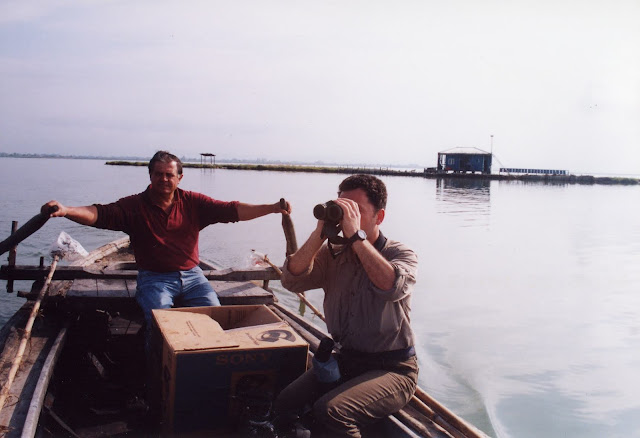 |
| Kostas Manikas (at the oars) was the most knowledgeable warden and keen expert fisherman of the lagoons, helping ornithologists here since the 1980s. Here with my friend Dimitris Papandropoulos with the binos - at the islet of the fishermen's lookout, on Logarou Lagoon. (In the box is a young pelican we confiscated from a tavern and we're returning it to the colony...what an ordeal that was...). |
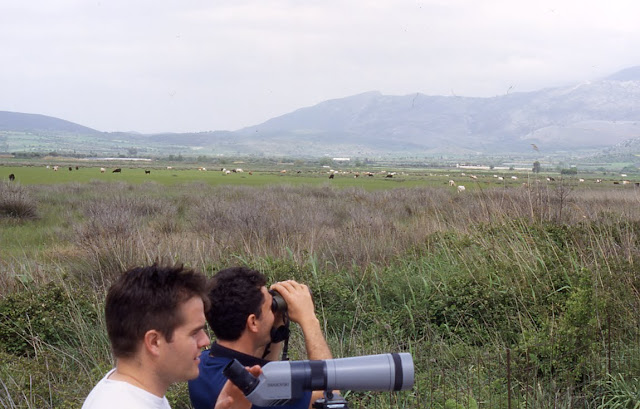 |
| Yiannis Kazoglou (with the Swarovski scope) and Dimitris Papandropoulos in an expedition near Lake Voulkaria. During our Life project we did a lot of exploratory work in amazing places all around the Gulf - even in the south. In March of 2008 the area became a huge National Park. I guess we did have a role to play in this - but we were not happy with the structure and final boundaries, too little, too late we thought... |
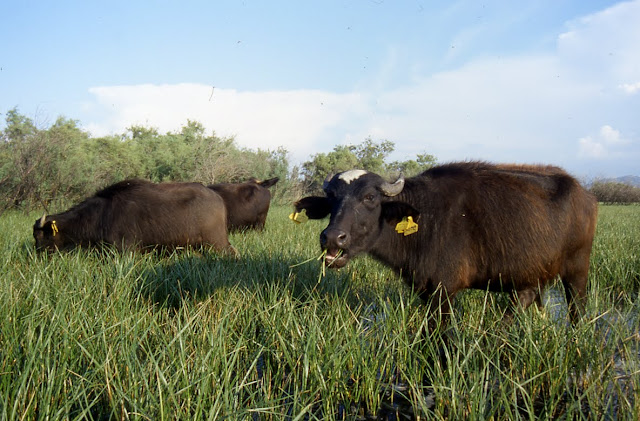 |
| I went all the way to Kerkini to learn about domesticated water buffalos in this project with the expert direction of Yannis Kazoglou- these are our first buffalos in the Rhodia Swamp. An outstanding time and big-step re-introduction for us (the species was extirpated in the late 60s from the Amvrakikos). After this, other re-introductions followed (i.e. Sperchios Delta) and the numbers of this beast increased in a few of Greece's large wetlands. During the project (I guess in 2002, we helped two MSc students work on studying the effects of the newly introduced water buffalos -this was an excellent gift of voluteer science for the area. |
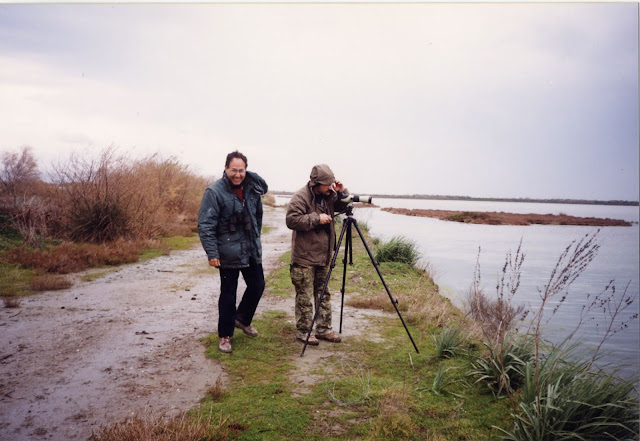 |
| One of my most trusted comrads-in-arms is zoologist Haralambos Alivizatos; here at the very begining of the Life Nature project in 1999 (I'm on the scope, a Nikon). This is a rainy day probably in 1999 - I seriously don't recall where in the Amvrakikos it is. |
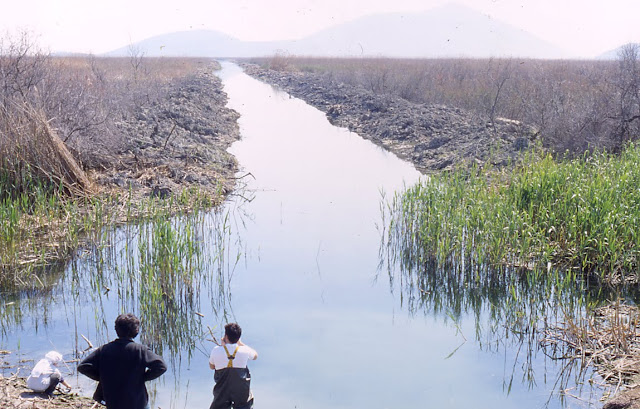 |
| The artificial canals we created to re-wet the vast Rhodia Swamp with waters from the Louros river. In this winter photo (2002) we can see Dimitris Papandropoulos, Vassiliki Vlami (wearing black) and Dimitris Zogaris (at about five years old...playing in the mud). This project was the largest most ambitious and most unusual wetland biodiversity restoration initiative ever done in Greece at the time. (Of course larger and more expernsive efforts took place aftewards, e.g. Karla). |
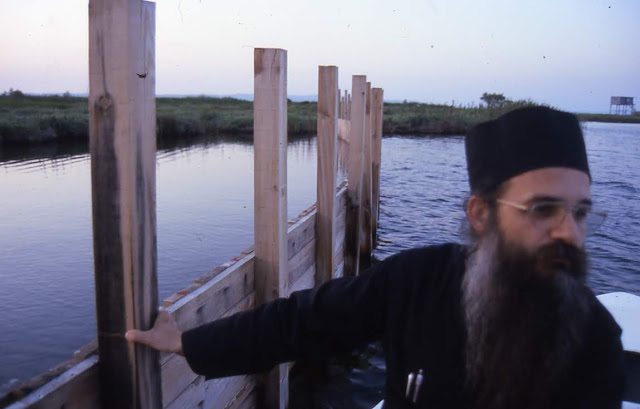 |
| The is Father Agathagellos of the Profitis Ilias Monestery of Preveza. He and his monastery were firm supporters of the conservation cause and helped me personally on many occasions. |
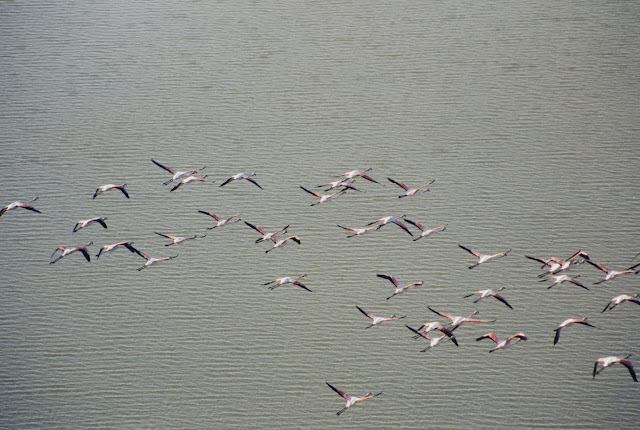 |
| Yes we did fly over a small flock of Greater Flamingos...in Logarou lagoon. |
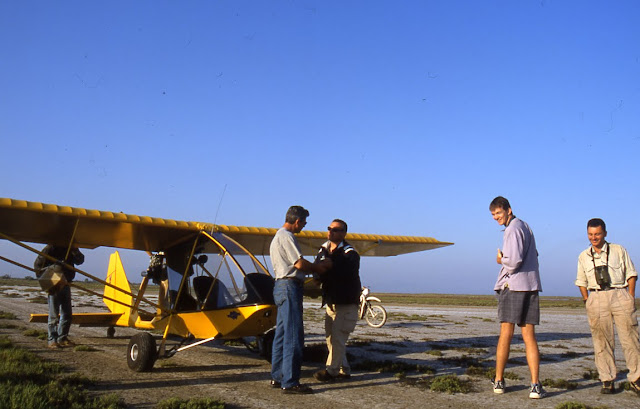 |
Getting ready to do some flying!!! ...for aereal photography in 2002 (no drones back then..). Last before Left (the tall one) is my good friend Dan Brown; one of the best naturalists who has ever worked with me at Amvrakikos. Dan came over from Bangor University (where I did my MSc degree) and spent much time helping us out.
|
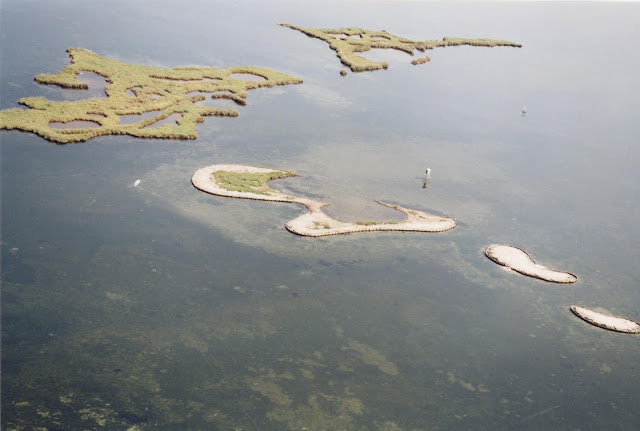 |
| Well this is an important air-photo I took of our four artificial islents in Avleri (Tsoukalio Lagoon). We built them to protect the Dalmatian Pelican colony. An important time for us - and new know-how developed. |
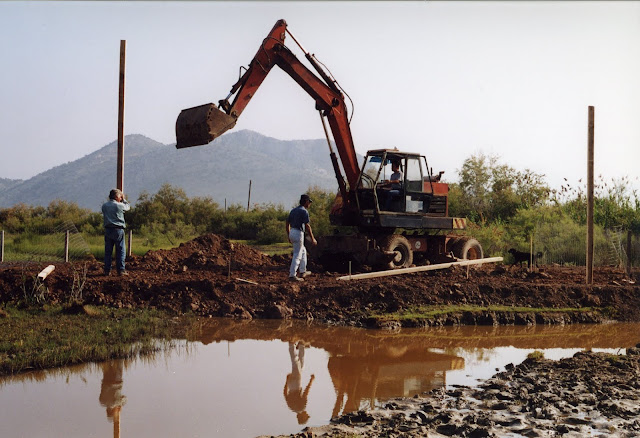 |
| We tried a lot at Amvrakikos and had amazing ideas to do new things - especially with the help of Thomas Arapis from Oikos Ltd. Here we are building the enclosure for the water buffalos and also doing some water works re-flooding outside the village of Stroghilli. |
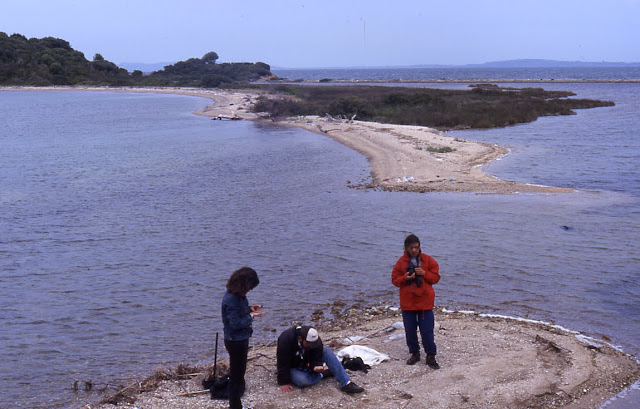 |
| Ornithology was responsible for a lot of our conservation initiatives at Amvrakikos. Here is pioneering ornithologist Kostas Papaconstantinou (siting), his wife ornithologist Niki Kardakari (in red) and my wife, ecotourism expert Vassiliki Vlami (at Left). We're on the Vouvalos islets in the middle of the Gulf surveying birds. Photo from 2000. |
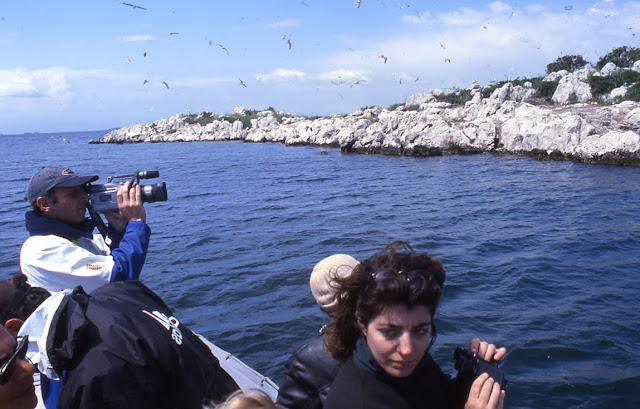 |
| We did a lot of bird explorations at the time throughout the Gulf -even the tiny islets. On left is the Ornithological Society's "Captain C. Papakonstantinou" with video camera. Vassiliki Vlami (bottom R). With the Hellenic Ornithological Society bird exploration. Photo from 2000. |
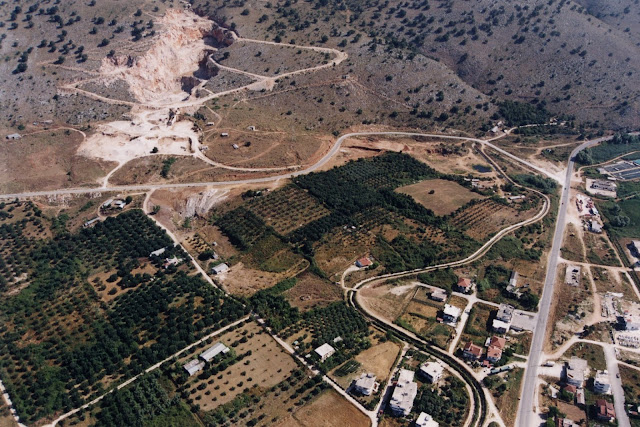 |
A BIG problem concerns landscape change and incremental changes happening with new roads, new citrus plantaions, rock quarries. This scene is next to the village of Louros, within the peripheral area of the National Park. Photo from 2002.
|
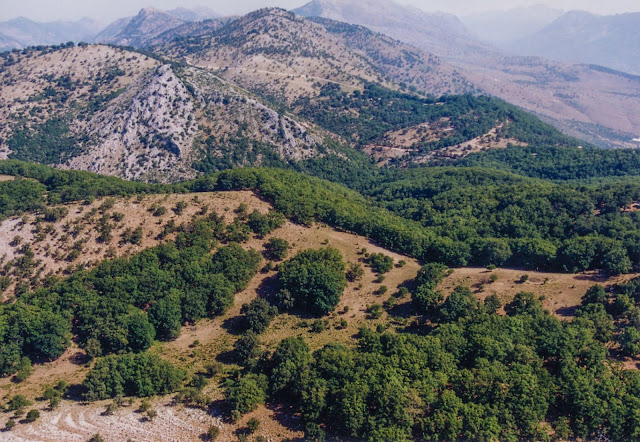 |
Critically important are some nearby hills and woods; where raptors such as the lesser spotted eagle nest. This is the Quercus frainetto forest of Mount Valaoritis. The site is outside the Natura 2000 boundary (but within the peripheral zone of the park); and unfortunately a smal rock-quarry and road construction displaced the nesting eagle in 2000. Photo from 2001.
|
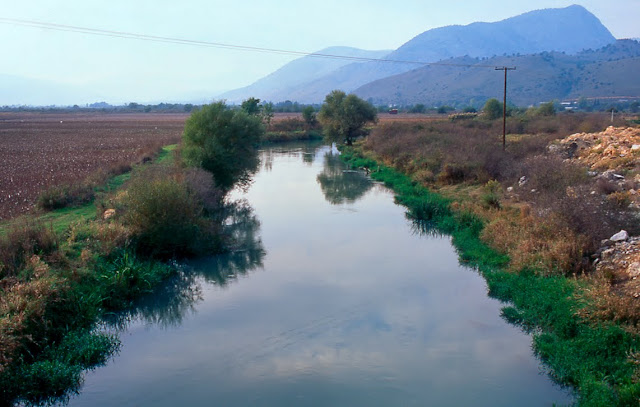 |
| The Louros river is the life-blood of the western part of the wetland; here at the Petra Bridge. Valaoritis mountain in the background. |
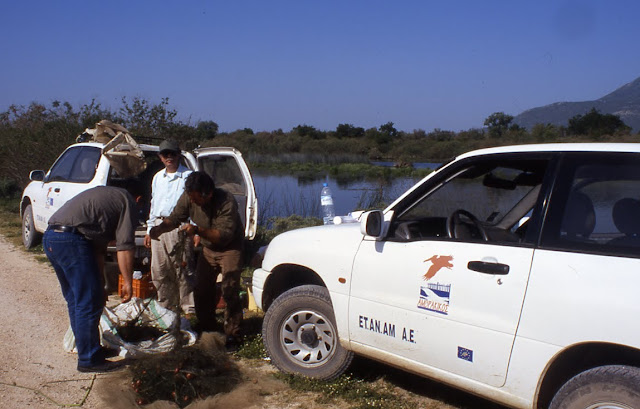 |
| With my mentor Alcibiades N. Economou and the famed ichthyologist Professor Peter Miller we did the first gill-netting research in Rhodia Swamp in 2001. This is on the Louros embankment. Note the "protected area" logos - the first ones we designed with OMEPE and OIKOS Ltd for the LIFE Nature project (this is before the National Park was enacted). |
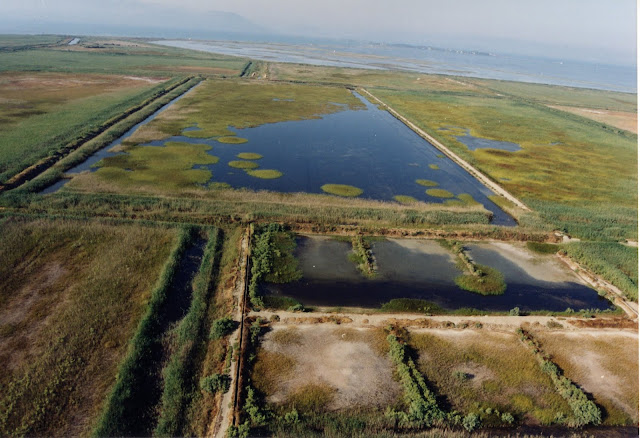 |
| The semi-abandoned fish-farm basins of the Psathotopi-Fidokastro area: here we discovered a new population of breeding bitterns and much much more... |
 |
| Typical wintry scene at Logarou with the city of Arta in the background. Along with the Dalmatian Pelican recovery we say a remarkable inclrease in herons and egrets in the last three decades. This photo we took with my friend Aris Vidalis on one of our winter visits. |
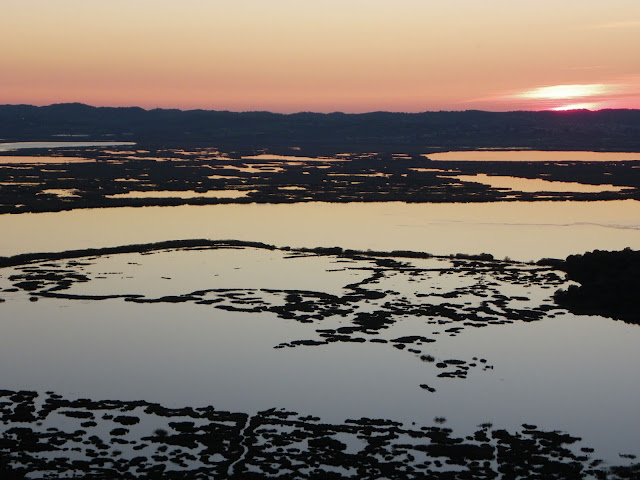 |
| My last visit was about 10 years ago with the film crew of Vaggelis Efthymiou. We drove with jeeps up to Mavrovouni for the sunset over the vast Rhodia Swamp. |

